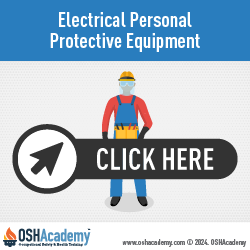Wear Correct PPE
OSHA requires that you be provided with personal protective equipment. This equipment must meet OSHA requirements and be appropriate for the parts of the body that need protection and the work performed.
There are many types of PPE: rubber gloves, insulating shoes and boots, face shields, safety glasses, hard hats, etc. Even if laws did not exist requiring the use of PPE, there would still be every reason to use this equipment. PPE helps keep you safe. It is the last line of defense between you and a hazard.
- Wear electrical protective equipment—Rubber insulating blankets, rubber insulating matting, rubber insulating covers, rubber insulating line hose, rubber insulating gloves, and rubber insulating sleeves.
- Wear safety glasses—Wear safety glasses to avoid eye injury.
- Wear proper clothing—Wear clothing that is neither floppy nor too tight. Loose clothing will catch on corners and rough surfaces. Clothing that binds is uncomfortable and distracting.
- Contain and secure loose hair—Wear your hair in such a way that it does not interfere with your work or safety.
- Wear proper foot protection—Wear shoes or boots that have been approved for electrical work. (Tennis shoes will not protect you from electrical hazards.) If there are non-electrical hazards present (nails on the floor, heavy objects, etc.), use footwear that is approved to protect against these hazards as well.
- Wear a hard hat—Wear the appropriate class A/G or B/E hard hat to protect your head from bumps, falling objects and electrical hazards. Do not wear Class C hard hats. Hard hats should be worn with the bill forward to protect you properly.
- Wear hearing protectors—Wear hearing protectors in noisy areas to prevent hearing loss.
- Follow directions—Follow the manufacturer's directions for cleaning and maintaining PPE.
- Make an effort—Search out and use any and all equipment that will protect you from shocks and other injuries.
Knowledge Check Choose the best answer for the question.
9-8. Which of the following is considered electrical protective equipment?
You forgot to answer the question!

